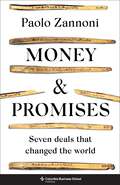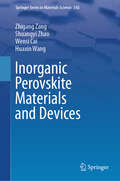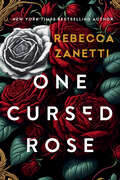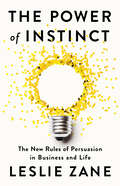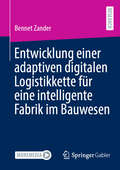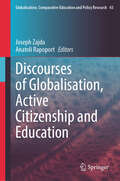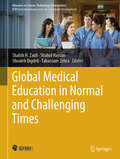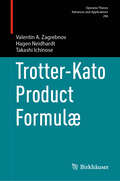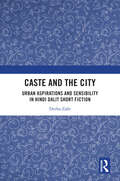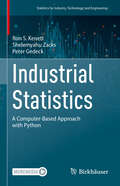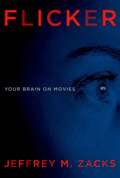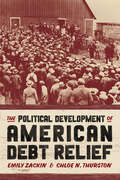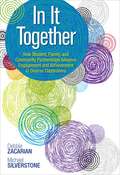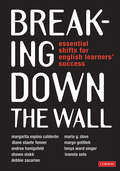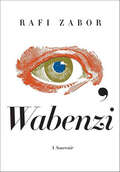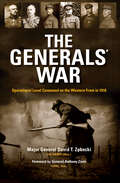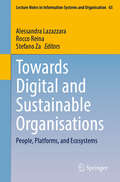- Table View
- List View
Money and Promises: Seven Deals That Changed the World
by Paolo ZannoniWhere did modern banking come from—and how does this history help us understand financial crises?In the twelfth century, Pisa was a thriving metropolis, a powerhouse of global trade, and a city that stood at the center of medieval Europe. But Pisa had a problem: Money came in the form of coins, and they were becoming scarce. In the face of this financial and monetary crisis, the foundations of modern banking were laid.In Money and Promises, the distinguished banker, executive, and historian Paolo Zannoni examines the complex relationship between states and banks that has changed the world. Drawing on in-depth archival research, he explores seven case studies: the republic of Pisa, seventeenth-century Venice, the early years of the Bank of England, imperial Spain, the Kingdom of Naples, the nascent United States during the American Revolution, and Bolshevik Russia in 1917 through 1923. Zannoni also tells the story of how the Continental Congress established the first public bank in North America, exploring the roles of Thomas Jefferson, Benjamin Franklin, and Alexander Hamilton. Spanning many countries, political systems, and historical eras, this book shows that at the heart of these institutions is an intricate exchange of debts and promises that shaped the modern world as we know it.
Inorganic Perovskite Materials and Devices (Springer Series in Materials Science #343)
by Zhigang Zang Wensi Cai Shuangyi Zhao Huaxin WangThis book describes in detail the reported synthesis methods of inorganic perovskite semiconductors, including nanocrystal, films, and single crystals. Then, the promising properties of inorganic perovskite semiconductors, such as high luminescent efficiencies, strong absorption, and excellent stability, are discussed and summarized. Owing to the attracted performance of inorganic perovskite semiconductors above, their potential applications in solid-state lighting and visible light communication, laser devices, solar cells, detectors, as well as electronic devices, are reviewed in this book. Apart from the conventional inorganic lead halide perovskites, lead-free metal halide perovskites are described and discussed. Finally, it also covers the recent challenges and perspectives of the inorganic perovskite semiconductors. This book is intended for undergraduate and graduate students who are interested in inorganic perovskites, researchers investigating novel inorganic perovskite, and engineers who working on the optimization of inorganic-perovskite-based devices.
One Cursed Rose (Grimm Bargains #1)
by Rebecca ZanettiFor fans of Scarlett St Clair and Sarah J Maas, New York Times bestselling author Rebecca Zanetti explores the forbidden and the taboo in this modern twist on Beauty and the Beast – the first in a seductive new dark romance series set in a world where information is power, and those who control the flow of information live like gods… &“Sexy and utterly engrossing!&” —bestselling author J.T. Geissinger They christened me Alana—and while the name means beauty, beneath that surface is a depth I allow very few to see. I&’m sole heir to Aquarius Social, a media giant about to succumb to an unseen enemy. My father&’s solution is to marry me off to the son of a competing family. My reaction? Not a chance. Now I have just a week before the wedding to change my fate. Who knew the unforeseen twist would be an assassination attempt on me and an unwanted rescue by Thorn Beathach, the head of the rival social media empire driving Aquarius under? The richest, most ruthless of them all, the Beast protects his realm with an iron rule: no one sees his face. When he shows himself to me, I know he&’ll never let me go. Thorn may think he can lock me in his enchanted castle forever, but I&’m not the docile Beauty he expects. If the Beast wants to tie me up, I&’m going to take pleasure from every minute of it . . .and we&’ll just see who ends up shackled.
One Cursed Rose: The captivating dark romantasy inspired by Beauty and the Beast
by Rebecca ZanettiFor fans of Scarlett St Clair and Sarah J Maas, New York Times bestselling author Rebecca Zanetti explores the forbidden and the taboo in this twist on Beauty and the Beast - the first in a seductive new dark romance series set in a world where information is power, and those who control the flow of information live like gods...'Sexy and utterly engrossing!' J.T. Geissinger'Zanetti launches a new series with this shadowy and violent twist on "Beauty and the Beast" that will appeal to readers looking for a uniquely magical world filled with seduction and betrayal' Library Journal _________________________Anyone can be swallowed by the darkest of shadows . . .Alana Beaumont is the sole heir to Aquarius Social - but with the company under attack from an unseen enemy, her father decides to marry her off to a rival family in the hopes of securing an alliance, leaving Alana torn between her family duty and her thirst for revenge as her wedding day approaches.But, following an unsuccessful assassination attempt, the wedding becomes the least of her concerns when she comes face to face with her rescuer: Thorn Beathach, owner of the rival business empire driving Aquarius under . . . and now her kidnapper.Known as the richest and most ruthless of them all, Thorn protects his realm with an iron fist, and no one sees his face. Until Alana.Convinced that she is only safe with him, Thorn wants to keep her in his enchanted castle forever, but she's not the docile beauty he expects, and he's not the only one who will find pleasure in their arrangement . . .
The Power of Instinct: The New Rules of Persuasion in Business and Life
by Leslie ZaneAward-winning Fortune 500 brand consultant and behavioral expert Leslie Zane shatters conventional marketing wisdom, showing readers how to tap into the hidden brain where instinct prevails, creating a powerful network of connections that drive people to buy your product, company, or vision. People don&’t make decisions with their conscious mind, but on instinct. In The Power of Instinct, marketing consultant and behavioral science expert Leslie Zane shows that to grow a brand, business, or even a social movement, traditional persuasion tactics fall short. Instead, you must connect to the instinctive mind. And to do this, you need to understand the science of consumer choice and employ techniques that work with a person&’s brain, not against it. Zane uncovers the hidden network of connections that dictates the snap decisions we make and cracks the code on how to influence it. With a revolutionary set of rules for expanding the network, Zane shows us how to make any brand, business, political candidate, or idea the dominant instinctive choice. With science as your guide, as well as stories from the world&’s most successful brands from McDonald's and Lululemon to the Yankees and Taylor Swift, you'll learn: What kind of messages create the greatest amount of positive associations; Why finding new customers accelerates growth and relying on existing ones is a trap; Why emotional stories are not enough to drive trial and long-term brand loyalty. Whether you're an entrepreneur, Fortune 500 executive, marketing professional, or job seeker, mastering the power of instinct will help supercharge your growth and make whatever you&’re selling the first choice for any audience.
Entwicklung einer adaptiven digitalen Logistikkette für eine intelligente Fabrik im Bauwesen
by Bennet ZanderDeutschland strebt bis 2045 eine Treibhausgasneutralität an und unternimmt in allen Wirtschaftssektoren Maßnahmen in diese Richtung. Da insbesondere Gebäude zu über 30 % der CO2-Emissionen beitragen, spielt das Bauwesen eine entscheidende Rolle bei der Verlangsamung des Klimawandels. Zukünftig können im Bauwesen intelligente Fabriken einen wesentlichen Beitrag zur Reduzierung von Emissionen leisten, da in diesen die Produktion von individuellen Fassaden- und Dachpaneelen für die energetische Gebäudesanierung entsprechend eines industriellen Maßstabs erfolgen kann. Dieses Buch bietet einen Ansatz für den Aufbau der Logistikkette einer intelligenten Fabrik im Bauwesen und veranschaulicht die digitale Verknüpfung von Beschaffungs-, Produktions-, Distributions- sowie Baustellenprozessen. Die Grundlage für die Systemintegration stellen Cyber-Physische Systeme, einheitliche Kommunikationsstandards und digitale Plattformen dar, wodurch ein transparenter Nachweis der Herkunft und der Prozessschritte vorliegt.
Crossing the Desert: The Power of Embracing Life's Difficult Journeys
by Payam ZamaniAt the age of 16, he escaped persecution and made his way to America as a refugee. At 28, he secured a billion-dollar IPO. Today, he&’s redefining what it means to be an entrepreneur by building a new model of capitalism.In the summer of 1987, Payam Zamani fled Iran. As a member of the Baha&’i Faith, he had already survived years of religious persecution at the hands of Islamic fundamentalists. Taking the only path available to him, he escaped to Pakistan through the Emptiness Desert: a harrowing five-day trek through one of the hottest, driest, and most hostile regions on the planet.Twelve years later, he and his brother set records when the company they founded hit a $1.2 billion valuation on Wall Street. He was rich—on paper. But in the wake of yet another Wall Street meltdown, he learned the hard way that modern capitalism can be harmful to the human soul.In 2015, Payam set the example he wanted to see by merging his business acumen with his spiritual beliefs and founding a new company—One Planet Group—this time without letting Wall Street or the venture capital world dictate the terms. Today, One Planet Group is proving that it&’s not only possible but necessary to build strong businesses while taking care of our employees, customers, communities, and the planet.Crossing the Desert gives readers an intimate look at how the paths we choose, the values we embrace, and the systems we decide to participate in (or not) can make or break us, not only financially, but spiritually. Payam&’s story is a timely reminder that enduring and embracing life&’s most difficult journeys can lead us to a brighter future—not only for ourselves, but for the people around us, and even the world.
Connected Medical Devices: Integrating Patient Care Data in Healthcare Systems (HIMSS Book Series)
by John ZaleskiThis book explores how medical device integration (MDI) supports quality patient care and better clinical outcomes by reducing clinical documentation transcription errors, improving data accuracy and density within clinical records and ensuring the complete capture of medical device information on patients. It begins with a comprehensive overview of the types of medical devices in use and the ways in which those devices interact, then examines factors such as interoperability standards, patient identification, clinical alerts and regulatory and security considerations.
Discourses of Globalisation, Active Citizenship and Education (Globalisation, Comparative Education and Policy Research #43)
by Joseph Zajda Anatoli RapoportThis book analyses dominant discourses of globalisation, and citizenship in schools. Diverse worldviews and ideologies construct different meanings for globalization, citizenship, and education, resulting in conceptual debates, tensions, competing discourses, and practical challenges for scholars and educators, navigating complex and contested terrain. The chapters in this volume advance further the discussions on the phenomenon of globalisation, and how it impacts on the nature of active citizenship education in schools around the world. In order to help students recognize that they are inherently global citizens, capable of understanding that local actions are globally interdependent, and that communities can be seen as temporal social networks within and beyond physical space, and action for global citizenship in school. The book, by building on intercultural dialogue and active citizenship education in schools, will promote critical appraisal of various views of the world, andoffers different ways to reconstruct and re-imagine social reality.
Global Medical Education in Normal and Challenging Times (Advances in Science, Technology & Innovation)
by Shabih H. Zaidi Shahid Hassan Shoaleh Bigdeli Tabassum ZehraThis book is written by several medical educators from developed as well as developing countries based on decades of experience in teaching. The unique experience gained during the COVID-19 pandemic has added new dimensions to the traditional pedagogy, andragogy, and heutagogy, documented here. The salient topics include distance learning, virtual classrooms, virtual workshops on OSCEs, open book exams, micro-learning, micro-credentialing, blended or digitalized curriculum delivery, academic leadership, communication skills, professionalism, telemedicine, bioethics, cyber clinics, artificial intelligence, etc. This book is used as a text or reference book by physicians, teachers, scholars, students, and medical universities for teachers' training, capacity building, and guidance on fundamental pillars of cognitive domains of knowledge, skills, and attitude, as well as factual, conceptual, procedural, and metacognitive skills. It is also a source of guidance in faculty enhancement and toward continued quality improvement in medical education.
Trotter-Kato Product Formulæ (Operator Theory: Advances and Applications #296)
by Valentin A. Zagrebnov Hagen Neidhardt Takashi IchinoseThe book captures a fascinating snapshot of the current state of results about the operator-norm convergent Trotter-Kato Product Formulæ on Hilbert and Banach spaces. It also includes results on the operator-norm convergent product formulæ for solution operators of the non-autonomous Cauchy problems as well as similar results on the unitary and Zeno product formulæ.After the Sophus Lie product formula for matrices was established in 1875, it was generalised to Hilbert and Banach spaces for convergence in the strong operator topology by H. Trotter (1959) and then in an extended form by T. Kato (1978). In 1993 Dzh. L. Rogava discovered that convergence of the Trotter product formula takes place in the operator-norm topology. The latter is the main subject of this book, which is dedicated essentially to the operator-norm convergent Trotter-Kato Product Formulæ on Hilbert and Banach spaces, but also to related results on the time-dependent, unitary and Zeno product formulæ. The book yields a detailed up-to-date introduction into the subject that will appeal to any reader with a basic knowledge of functional analysis and operator theory. It also provides references to the rich literature and historical remarks.
Caste and the City: Urban Aspirations and Sensibility in Hindi Dalit Short Fiction
by Deeba ZafirThis book looks at Dalits in the city and examines the nature of Dalit aspirations as well as the making of an urban sensibility through an analysis of hitherto unexamined short stories of some of the first- and second-generation as well as contemporary Dalit writers in Hindi.Tracing the origins of the emergence of Dalit critical consciousness to the arrival of the Dalits into the print medium, after their migration to the city, this book examines their transactions with modernity and the emancipatory promises it held out to them. It highlights the literary tropes that mark their fiction, specifically those short stories which take up urban themes, and shows how even in seemingly caste-neutral spaces caste discrimination is present. The book also undertakes an examination of the stories by contemporary Dalit women writers in Hindi – Rajat Rani Meenu and Anita Bharti – who have posed a radical challenge to both the mainstream feminist movement and the Dalit movement.The volume will be of great interest to scholars and researchers of South Asian literature, especially Hindi literature, Dalit studies, subaltern history, postcolonial studies, political science, and sociology as well as the informed general reader.
Industrial Statistics: A Computer-Based Approach with Python (Statistics for Industry, Technology, and Engineering)
by Shelemyahu Zacks Ron S. Kenett Peter GedeckThis innovative textbook presents material for a course on industrial statistics that incorporates Python as a pedagogical and practical resource. Drawing on many years of teaching and conducting research in various applied and industrial settings, the authors have carefully tailored the text to provide an ideal balance of theory and practical applications. Numerous examples and case studies are incorporated throughout, and comprehensive Python applications are illustrated in detail. A custom Python package is available for download, allowing students to reproduce these examples and explore others.The first chapters of the text focus on the basic tools and principles of process control, methods of statistical process control (SPC), and multivariate SPC. Next, the authors explore the design and analysis of experiments, quality control and the Quality by Design approach, computer experiments, and cybermanufacturing and digital twins. The text then goes on to cover reliability analysis, accelerated life testing, and Bayesian reliability estimation and prediction. A final chapter considers sampling techniques and measures of inspection effectiveness. Each chapter includes exercises, data sets, and applications to supplement learning.Industrial Statistics: A Computer-Based Approach with Python is intended for a one- or two-semester advanced undergraduate or graduate course. In addition, it can be used in focused workshops combining theory, applications, and Python implementations. Researchers, practitioners, and data scientists will also find it to be a useful resource with the numerous applications and case studies that are included. A second, closely related textbook is titled Modern Statistics: A Computer-Based Approach with Python. It covers topics such as probability models and distribution functions, statistical inference and bootstrapping, time series analysis and predictions, and supervised and unsupervised learning. These texts can be used independently or for consecutive courses.This book is part of an impressive and extensive write up enterprise (roughly 1,000 pages!) which led to two books published by Birkhäuser. This book is on Industrial Statistics, an area in which the authors are recognized as major experts. The book combines classical methods (never to be forgotten!) and “hot topics” like cyber manufacturing, digital twins, A/B testing and Bayesian reliability. It is written in a very accessible style, focusing not only on HOW the methods are used, but also on WHY. In particular, the use of Python, throughout the book is highly appreciated. Python is probably the most important programming language used in modern analytics. The authors are warmly thanked for providing such a state-of-the-art book. It provides a comprehensive illustration of methods and examples based on the authors longstanding experience, and accessible code for learning and reusing in classrooms and on-site applicationsProfessor Fabrizio RuggeriResearch Director at the National Research Council, ItalyPresident of the International Society for Business and Industrial Statistics (ISBIS)Editor-in-Chief of Applied Stochastic Models in Business and Industry (ASMBI)
Flicker: Your Brain On Movies
by Jeffrey ZacksHow is it that a patch of flickering light on a wall can produce experiences that engage our imaginations and can feel totally real? From the vertigo of a skydive to the emotional charge of an unexpected victory or defeat, movies give us some of our most vivid experiences and most lasting memories. They reshape our emotions and worldviews--but why? In Flicker, Jeff Zacks delves into the history of cinema and the latest research to explain what happens between your ears when you sit down in the theatre and the lights go out. Some of the questions Flicker answers: Why do we flinch when Rocky takes a punch in Sylvester Stallone's movies, duck when the jet careens towards the tower in Airplane, and tap our toes to the dance numbers in Chicago or Moulin Rouge? Why do so many of us cry at the movies? What's the difference between remembering what happened in a movie and what happened in real life--and can we always tell the difference? To answer these questions and more, Flicker gives us an engaging, fast-paced look at what happens in your head when you watch a movie.
The Political Development of American Debt Relief
by Emily Zackin Chloe N. ThurstonA political history of the rise and fall of American debt relief. Americans have a long history with debt. They also have a long history of mobilizing for debt relief. Throughout the nineteenth century, indebted citizens demanded government protection from their financial burdens, challenging readings of the Constitution that exalted property rights at the expense of the vulnerable. Their appeals shaped the country’s periodic experiments with state debt relief and federal bankruptcy law, constituting a pre-industrial safety net. Yet, the twentieth century saw the erosion of debtor politics and the eventual retrenchment of bankruptcy protections. The Political Development of American Debt Relief traces how geographic, sectoral, and racial politics shaped debtor activism over time, enhancing our understanding of state-building, constitutionalism, and social policy.
In It Together: How Student, Family, and Community Partnerships Advance Engagement and Achievement in Diverse Classrooms
by Debbie Zacarian Michael A. SilverstoneHarness the power of teacher, student, school, family, and community partnerships to promote student success Teaching effectively in diverse classrooms has become more complex than ever. The authors of this practical, compelling, and inspiring book propose that understanding the spheres of influence that connect students with teachers, peers, family members, and the broader community significantly increases the odds that every student will succeed in school. In clear, practitioner-friendly language with examples from an inspiring range of K-12 educators, the authors explore how tapping into the rich resources of teachers, students, families, the school community and the community-at-large can make the work of learning more successful for all involved. Richly detailed vignettes and concrete, evidence-based strategies help you systematically: Build coalitions of support around learning and engagement Develop positive relationships with students, their families and their communities Foster positive, reciprocal partnerships Promote peer-to-peer relationship building Support students and families from marginalized populations Learn to draw from the rich resources found within your learning community to build bridges to academic success for all learners. This comprehensive book shows you how! "Building meaningful relationships in education can be difficult, particularly when the parties involved are different from one another in identity, experience, and other ways. As a result, although in principle collaborations and partnerships in education are universally lauded, in practice they are often ignored. What we need are examples of partnerships that work. In it Together by Debbie Zacarain and Michael Silverstone suggests productive ways to work with, learn from, and form authentic relationships with diverse communities. Combining their abundant experience in classrooms and schools, and using examples from caring teachers in diverse classrooms, the authors demonstrate what it means to really be "in it together." Teachers, administrators, and everyone who cares about the future of education in a diverse society will benefit from the strategies they suggest." —Sonia Nieto, Professor Emerita University of Massachusetts
In It Together: How Student, Family, and Community Partnerships Advance Engagement and Achievement in Diverse Classrooms
by Debbie Zacarian Michael A. SilverstoneHarness the power of teacher, student, school, family, and community partnerships to promote student success Teaching effectively in diverse classrooms has become more complex than ever. The authors of this practical, compelling, and inspiring book propose that understanding the spheres of influence that connect students with teachers, peers, family members, and the broader community significantly increases the odds that every student will succeed in school. In clear, practitioner-friendly language with examples from an inspiring range of K-12 educators, the authors explore how tapping into the rich resources of teachers, students, families, the school community and the community-at-large can make the work of learning more successful for all involved. Richly detailed vignettes and concrete, evidence-based strategies help you systematically: Build coalitions of support around learning and engagement Develop positive relationships with students, their families and their communities Foster positive, reciprocal partnerships Promote peer-to-peer relationship building Support students and families from marginalized populations Learn to draw from the rich resources found within your learning community to build bridges to academic success for all learners. This comprehensive book shows you how! "Building meaningful relationships in education can be difficult, particularly when the parties involved are different from one another in identity, experience, and other ways. As a result, although in principle collaborations and partnerships in education are universally lauded, in practice they are often ignored. What we need are examples of partnerships that work. In it Together by Debbie Zacarain and Michael Silverstone suggests productive ways to work with, learn from, and form authentic relationships with diverse communities. Combining their abundant experience in classrooms and schools, and using examples from caring teachers in diverse classrooms, the authors demonstrate what it means to really be "in it together." Teachers, administrators, and everyone who cares about the future of education in a diverse society will benefit from the strategies they suggest." —Sonia Nieto, Professor Emerita University of Massachusetts
Breaking Down the Wall: Essential Shifts for English Learners’ Success
by Debbie Zacarian Maria G. Dove Margarita Espino Calderon Diane Staehr Fenner Tonya W. Singer Margo Gottlieb Ivannia Soto Shawn M. Sinclair-Slakk Andrea HonigsfeldIt was a dark and stormy night in Santa Barbara. January 19, 2017. The next day’s inauguration drumroll played on the evening news. Huddled around a table were nine Corwin authors and their publisher, who together have devoted their careers to equity in education. They couldn’t change the weather, they couldn’t heal a fractured country, but they did have the power to put their collective wisdom about EL education upon the page to ensure our multilingual learners reach their highest potential. Proudly, we introduce you now to the fruit of that effort: Breaking Down the Wall: Essential Shifts for English Learners’ Success. In this first-of-a-kind collaboration, teachers and leaders, whether in small towns or large urban centers, finally have both the research and the practical strategies to take those first steps toward excellence in educating our culturally and linguistically diverse children. It’s a book to be celebrated because it means we can throw away the dark glasses of deficit-based approaches and see children who come to school speaking a different home language for what they really are: learners with tremendous assets. The authors’ contributions are arranged in nine chapters that become nine tenets for teachers and administrators to use as calls to actions in their own efforts to realize our English learners’ potential: 1. From Deficit-Based to Asset-Based 2. From Compliance to Excellence 3. From Watering Down to Challenging 4. From Isolation to Collaboration 5. From Silence to Conversation 6. From Language to Language, Literacy, and Content 7. From Assessment of Learning to Assessment for and as Learning 8. From Monolingualism to Multilingualism 9. From Nobody Cares to Everyone/Every Community Cares Read this book; the chapters speak to one another, a melodic echo of expertise, classroom vignettes, and steps to take. To shift the status quo is neither fast nor easy, but there is a clear process, and it’s laid out here in Breaking Down the Wall. To distill it into a single line would go something like this: if we can assume mutual ownership, if we can connect instruction to all children’s personal, social, cultural, and linguistic identities, then all students will achieve.
Breaking Down the Wall: Essential Shifts for English Learners’ Success
by Debbie Zacarian Maria G. Dove Margarita Espino Calderon Diane Staehr Fenner Tonya W. Singer Margo Gottlieb Ivannia Soto Shawn M. Sinclair-Slakk Andrea HonigsfeldIt was a dark and stormy night in Santa Barbara. January 19, 2017. The next day’s inauguration drumroll played on the evening news. Huddled around a table were nine Corwin authors and their publisher, who together have devoted their careers to equity in education. They couldn’t change the weather, they couldn’t heal a fractured country, but they did have the power to put their collective wisdom about EL education upon the page to ensure our multilingual learners reach their highest potential. Proudly, we introduce you now to the fruit of that effort: Breaking Down the Wall: Essential Shifts for English Learners’ Success. In this first-of-a-kind collaboration, teachers and leaders, whether in small towns or large urban centers, finally have both the research and the practical strategies to take those first steps toward excellence in educating our culturally and linguistically diverse children. It’s a book to be celebrated because it means we can throw away the dark glasses of deficit-based approaches and see children who come to school speaking a different home language for what they really are: learners with tremendous assets. The authors’ contributions are arranged in nine chapters that become nine tenets for teachers and administrators to use as calls to actions in their own efforts to realize our English learners’ potential: 1. From Deficit-Based to Asset-Based 2. From Compliance to Excellence 3. From Watering Down to Challenging 4. From Isolation to Collaboration 5. From Silence to Conversation 6. From Language to Language, Literacy, and Content 7. From Assessment of Learning to Assessment for and as Learning 8. From Monolingualism to Multilingualism 9. From Nobody Cares to Everyone/Every Community Cares Read this book; the chapters speak to one another, a melodic echo of expertise, classroom vignettes, and steps to take. To shift the status quo is neither fast nor easy, but there is a clear process, and it’s laid out here in Breaking Down the Wall. To distill it into a single line would go something like this: if we can assume mutual ownership, if we can connect instruction to all children’s personal, social, cultural, and linguistic identities, then all students will achieve.
Beyond Crises: Overcoming Linguistic and Cultural Inequities in Communities, Schools, and Classrooms
by Debbie Zacarian Margarita Espino Calderon Margo GottliebWhat are some lessons learned from the pandemic? We learned that, in times of crises, the humanitarian needs of students, families, and ourselves must be a top priority. We learned that forming effective partnerships with families and communities is essential to the health and well-being of our children. We were offered a blunt reminder that a system designed to serve the interests of a privileged few was destined to fail our historically underserved students, especially our millions of multilingual learners. Above all, we learned that the "normal" many of us have yearned for was never good enough—that we must envision a "better world," where we build on our multilingual students’ unique assets and cultivate their inner brilliance. Only then will we deliver on their promise. It’s this "better world," a world in which communities, schools, and classrooms work together as a "whole-child ecosystem," Beyond Crises: Overcoming Linguistic and Cultural Inequities in Communities, Schools, and Classrooms sets out to create. Taking a look from the outside in, Debbie Zacarian, Margarita Calderón, and Margo Gottlieb address three critical arenas: 1. Imagining Communities describes how to design and enact strengths-based family and community partnerships, including the critical importance of identifying, valuing, and acknowledging each member’s assets and competencies, and the ways recent crises have amplified their struggles. 2. Imagining Schools takes an up-close look at policies, structures, and now irrelevant ways of schooling that call for change and how we might reconfigure professional development to ensure every teacher and administrator is dedicated to the well-being and success of our multilingual learners. 3. Imagining Classrooms demonstrates how to optimize learning opportunities—both virtual and face-to-face—so our diverse students grow cognitively, linguistically, and social-emotionally, and accentuate their talents in knowing and using multiple languages in linguistically and culturally sustainable environments. "Student and family, classroom, school, and local community are not silos unto themselves," Debbie, Margarita, and Margo insist. "They are part of a larger whole that is interrelated and interconnected and, even, interdependent on each other. By forming stronger alliances, we can realize the power of truly working, socializing, and flourishing together." Beyond Crises is the first critical step forward.
Beyond Crises: Overcoming Linguistic and Cultural Inequities in Communities, Schools, and Classrooms
by Debbie Zacarian Margarita Espino Calderon Margo GottliebWhat are some lessons learned from the pandemic? We learned that, in times of crises, the humanitarian needs of students, families, and ourselves must be a top priority. We learned that forming effective partnerships with families and communities is essential to the health and well-being of our children. We were offered a blunt reminder that a system designed to serve the interests of a privileged few was destined to fail our historically underserved students, especially our millions of multilingual learners. Above all, we learned that the "normal" many of us have yearned for was never good enough—that we must envision a "better world," where we build on our multilingual students’ unique assets and cultivate their inner brilliance. Only then will we deliver on their promise. It’s this "better world," a world in which communities, schools, and classrooms work together as a "whole-child ecosystem," Beyond Crises: Overcoming Linguistic and Cultural Inequities in Communities, Schools, and Classrooms sets out to create. Taking a look from the outside in, Debbie Zacarian, Margarita Calderón, and Margo Gottlieb address three critical arenas: 1. Imagining Communities describes how to design and enact strengths-based family and community partnerships, including the critical importance of identifying, valuing, and acknowledging each member’s assets and competencies, and the ways recent crises have amplified their struggles. 2. Imagining Schools takes an up-close look at policies, structures, and now irrelevant ways of schooling that call for change and how we might reconfigure professional development to ensure every teacher and administrator is dedicated to the well-being and success of our multilingual learners. 3. Imagining Classrooms demonstrates how to optimize learning opportunities—both virtual and face-to-face—so our diverse students grow cognitively, linguistically, and social-emotionally, and accentuate their talents in knowing and using multiple languages in linguistically and culturally sustainable environments. "Student and family, classroom, school, and local community are not silos unto themselves," Debbie, Margarita, and Margo insist. "They are part of a larger whole that is interrelated and interconnected and, even, interdependent on each other. By forming stronger alliances, we can realize the power of truly working, socializing, and flourishing together." Beyond Crises is the first critical step forward.
I, Wabenzi: A Souvenir
by Rafi ZaborSome time ago Rafi Zabor sat down to write a brief narrative of the year 1986. That was the year he set out across two continents in a used Mercedes--"Wabenzi" is the Swahili word for a member of the Mercedes-owning class--to buy a grave stone for his friend Mahmoud Rauf and to outrun the shadow of his own parents' recent death.But like a boat against the current, the writer was drawn back into the past: his father's escape from the Nazis, Rafi's own Brooklyn boyhood surrounded by the fractious, Zabors and Zaborovskys, and the anguished--sometimes farcical--spiritual journey that led Zabor from Brooklyn to Turkey by way of Coltrane, the thirteenth-century mystic Muhyiddin Ibn ‘Arabi, the McGovern campaign, Gurdjieff, a shoe salesman named Gogol, and the cataclysmic months Zabor spent studying (and whirling) amid a band of Sufis in rural England. The result--the first of a projected four volumes--is one of the most original, capacious, and vivid narratives of the last few decades, a real-life Bildungsroman dealing with an expanded range of human experience, from matters of life and death to a piece of what lies beyond them. Straight from the unchartered territory between Zen and the Art of Motorcycle Maintenance and Tristram Shandy, I, Wabenzi lifts a corner of the known world as if it were the edge of a curtain, and begins to show a reality new to our literature gleaming on the other side.
Sustainable Business in the Era of Digital Transformation: Strategic and Entrepreneurial Perspectives (ISSN)
by Vesna Zabkar Marek Ćwiklicki Mariusz Sołtysik Magdalena Wojnarowska Maria Urbaniec Erica VareseSustainable development is a complex issue and despite many studies and publications in recent years, it remains poorly recognised on best practices in core business areas. Achieving the Sustainable Development Goals in accordance with the 2030 Agenda for Sustainable Development depends on research and innovation. Therefore, the transition to sustainable development requires investment in technology, new business models, and social and environmental innovations that contribute to shaping new business and promoting sustainable business practices.This book seeks to understand how sustainability affects core business areas, with a focus on strategic and entrepreneurial activities. Given these considerations, the main purpose of this book is twofold: (1) to contribute to a better understanding of important and current trends in the field of sustainable transformation in core business areas; and (2) to provide a comprehensive overview of quantitative and qualitative studies in the field. The book ultimately seeks to shed light on how companies are implementing sustainable transformation in the core areas of product and marketing, entrepreneurship, and innovation, which is supported by appropriate project management strategies.The book provides researchers and upper-level students in economics, business, and other social sciences with an overview of interdisciplinary theoretical and conceptual perspectives and frameworks for successful business transformation. It will be of particular value to those researching sustainable development and strategic management.
The Generals' War: Operational Level Command on the Western Front in 1918 (Twentieth-Century Battles)
by Major General David T. ZabeckiKnown as the War to End all Wars and the Great War, World War I introduced new forms of mass destruction and modern technological warfare. When the Bolsheviks pulled Russia out of the war in late 1917, the Germans turned their offensive efforts to the Western Front in an attempt to win the war in 1918. But as fresh American troops entered Europe, the strategic scales tipped against Germany.Much of how World War I played out turned on the plans and decisions of the senior-most German and Allied commanders. The Generals' War explores the military strategies of those generals during the last year of the Great War. These six very different men included Germany's Field Marshal Paul von Hindenburg and General Erich Ludendorff; France's Marshals Ferdinand Foch and Philippe Pétain; Great Britain's Field Marshal Sir Douglas Haig; and the United States' General John Pershing. Although history remembers none of them as great captains, these six officers determined for better or worse how World War I was fought on the battlefields of the Western Front between November 1917 and November 1918.The Generals' War is a landmark exploration of the generalship that shaped the very framework of modern warfare as we know it today and provides a comprehensive and detailed analysis on the senior commanders of the Great War.
Towards Digital and Sustainable Organisations: People, Platforms, and Ecosystems (Lecture Notes in Information Systems and Organisation #65)
by Stefano Za Alessandra Lazazzara Rocco ReinaThis book presents a collection of research papers that explore how ICT experts, managers, and policymakers can address sustainability issues in digital transformation (DT) by considering people practices, organizational processes, and platform design issues. Each chapter offers insights into how to create sustainable digital solutions that benefit both society and the environment. The diversity of views presented makes this book particularly relevant for scholars, companies, and public sector organizations. The content is based on revised versions of selected papers (original double-blind peer-reviewed contributions) presented at the annual conference of the Italian Chapter of AIS, which took place in Catanzaro, Italy, in October 2022.
